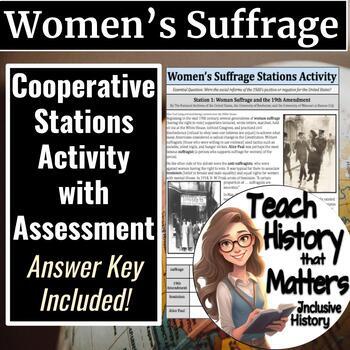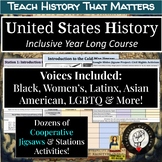Women’s Suffrage Stations Activity with Primary Sources & Political Cartoons
- Google Docs™

Also included in
- This U.S. History year-long course examines the major events and turning points of U.S. history from the Civil War through the Civil Rights Movement. The course leads students toward a clearer understanding of the patterns, processes, and people that have shaped U.S. history. During this year long UPrice $158.39Original Price $270.48Save $112.09
Description
Women's Suffrage 1920's Political Cartoon & Primary Source Inquiry Activity
Stations Activity with Teacher Answer Guide!
Essential Question: Were the social reforms of the 1920’s positive or negative for the United States?
Women had to fight for equal rights. Many students don't realize much of American society was opposed to the 19th Amendment in the 1920's. This lesson has students will work in groups and answer guided reading questions and they unpack each authors argument. Students will unpack the argument for and against women's suffrage and then will then look at political cartoons from the 1920's to determine whether they are pro-suffrage or anti-suffrage. Students must make their own political cartoon to show their understanding of the women's suffrage movement. At the end of the lesson students will complete an assessment writing assignment. Students will write a claim, counterclaim, evidence and reasoning using the readings from the class to answer the question: How was the passage of the 19th Amendment a historical landmark for American society?
15 Stations Primary Sources Analysis:
The National Archives of the United States, the University of Rochester, and the University of Missouri at Kansas City
Equality of the Sexes by Rev. John Todd (1867)
The Progress of Fifty Years By Lucy Stone (1893)
New York Times Article
10 political cartoons
Vocabulary:
Suffrage
19th Amendment
Alice Paul
Lucy Stone
feminism
anti-suffragist
Included:
primary sources (readings and cartoons)
guided reading questions
graphic organizers
writing help (sentence starters)
answer key
CA History Standards
11.5 Students analyze the major political, social, economic, technological, and cultural developments of the 1920s.
4. Analyze the passage of the Nineteenth Amendment and the changing role of women in society
Tips for More Products:
Follow my store by simply clicking the little green star next to my name, and my new products will appear on the front page of your TPT account!
Did you know you can earn TPT credit towards future purchases?
Make sure you’re logged into your account and find your My Purchases page. For each purchase you’ve made, make sure to leave feedback (the more detailed, the better!). This feedback earns you credit towards future purchases - it’s like free TPT money! Even more important, feedback is vital, as it helps me to create new products and revise and expand on current products to make them more inclusive, engaging, and rigorous. If you have any questions regarding a TPT product you’ve purchased from me, simply leave a message and I will be sure to respond as soon as possible!



